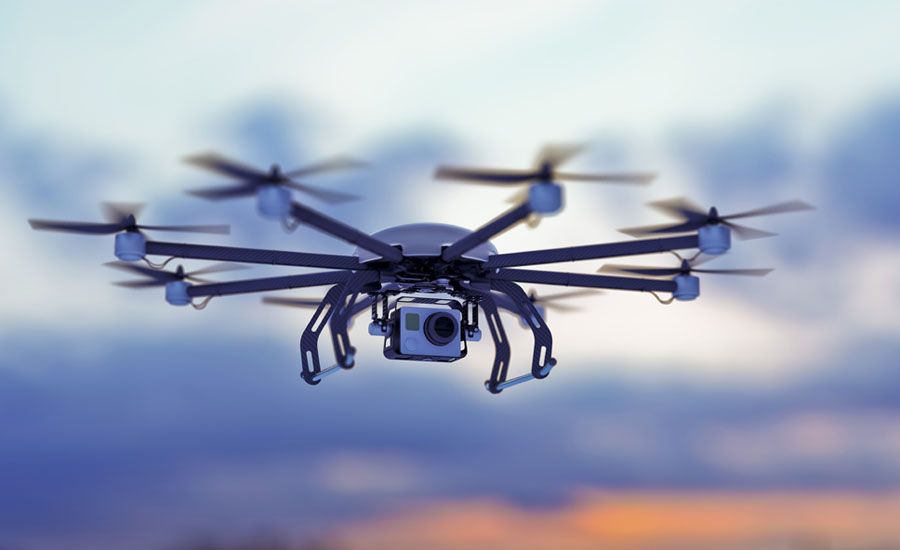A NIOSH Science Blog post
Can drones make construction safer?

Unmanned aerial vehicles (UAVs) often called drones are increasingly used for military, recreational, public, and commercial purposes. UAVs have the potential to prevent injury and death in the construction industry where nearly 1,000 workers died in 2015. Advancements in UAV technology could help reduce construction-related injury and death from falls, toxic chemical exposures, electrical hazards, or traumatic injury from vehicle and equipment collisions.
As is the case with other emerging technologies, occupational safety assessments of UAVs lag behind technological advancements. UAVs may create new workplace hazards that need to be evaluated and managed to ensure their safe operation around human workers. A recent paper from the National Institute for Occupational Safety and Health (NIOSH) in the American Journal of Industrial Medicine “Unmanned Aerial Vehicles in Construction and Worker Safety” describes the four major uses of UAVs, including their use in construction, the potential risks of their use to workers, approaches for risk mitigation, and the important role that safety and health professionals can play in ensuring safe approaches to their use in the workplace.
While the article provides a wealth of information on the major uses of UAVs, this blog focuses on UAV use in construction. The commercial segment of the $100 billion UAV market is predicted to be the fastest growing between 2016 and 2020, with the construction industry accounting for the largest share of the growth.1 By 2025, the U.S. commercial UAV sector is forecast to surpass five billion dollars in investments.2
The emerging uses of UAVs in the construction industry range from aiding with construction project planning by aerial mapping of the construction site3 to extending to the actual building of structures.4,5 The most common UAV uses in construction are described below.
Monitoring: Monitoring a large construction site is a challenge for construction management. A UAV can be deployed to send video footage of site conditions to construction management faster and more efficiently than can on-the-ground personnel. Video can be converted into a three-dimensional picture of the site and then compared to computerized architectural plans to show how accurately the project is progressing.6 Monitoring information obtained by a UAV also serves as a useful input in the preparation of periodic construction progress reports. UAVs can be equipped with far and near infrared cameras, radar or laser-based range finders which can greatly enhance their surveillance and monitoring capabilities at a construction site.7 In addition, tracking moving objects on construction sites such as people, equipment, and material are being developed,8 as well as equipping UAVs with the capability of mapping indoor construction environments.9
Inspection: Often, UAVs can inspect a large worksite more efficiently through aerial photography than on-the-ground personnel can. UAV detection of hazardous conditions, materials and dangerous structures can aid in construction site hazard identification without placing a worker at risk.10,11 Real-time UAV systems performing remote site inspections and violation detection at construction sites may be more efficient, safer and less costly than present construction site inspection methods.7,12 UAV inspection of awkward locations on and under bridges and along highway can not only reduce the cost of personnel inspecting the entire expanse of a highway road or structure, but also reduce the risk of working along a busy highway or erecting equipment close to the flow of traffic. Government inspections of construction sites could also be performed by a UAV. Because inspection of the site would be quicker than an individual government inspector walking an extensive construction site, UAVs could increase the scope and frequency of inspections of construction projects by federal, state and local government agencies.13 Once potential violations were identified by aerial imaging, then inspectors could focus their investigation on sites where the potential violations were imaged.
Maintenance: Using UAVs in carrying out planned or reactive maintenance inspections of tall structures, such as skyscrapers, bridges, and towers where access can be costly and pose a risk to workers of falling from a great height, appears to be a clear benefit for construction workers and managers.14 New FAA rules permitting the commercial use of UAVs has prompted new guidelines for operating UAVs around vertical communications infrastructure.15
Other Uses: UAVs have been proposed as material handling vehicles, transporting tools, equipment and materials at construction sites16 or used to spray paint or waterproof a structural component.17 UAVs can also be used to capture unique views of a structure for promotional photographic purposes.14
Safety
While there are many benefits to using UAVs in construction, the potential risks must be carefully studied. The presence of a UAV flying in close proximity to a human worker can create new hazards at a construction site, although data supporting the hazard potential of UAVs for workers are scarce. Safety professionals need to be aware of these new hazards, assess the risks arising from them, and apply controls to reduce the risks. There has been little published about the safety and health risks associated with the public or commercial use of UAVs. The military has begun to assess the adverse health effects among remote pilots operating UAVs over conflict areas and has reported stress reactions in military personnel arising from their work as UAV operators.18,19
About 30 incidents of near-misses or crashes leading to human injury have been reported associated with the use of recreational UAVs.20 Unstable flying conditions, operator errors, and faulty equipment may represent potential hazards to nearby workers from the commercial use of UAVs. Adding to the uncertainty about the hazards to workers from the emerging use of UAVs in construction and other industries, the arrival of autonomous or semi-autonomous UAVs may introduce new hazards arising from the absence of human control.
It is important to develop hazard identification, risk characterization and mitigation approaches to ensure the safe operation of commercial UAVs as the use of UAVs promises significant benefits for industry. These approaches might incorporate prevention-through design concepts such as lightweight manipulators, passive compliant systems, safe actuators, and passive robotic systems. Navigation and collision avoidance systems can be included in the design of commercial UAVs as a proactive safety measure. Collision avoidance in the three-dimensional environment is a main area of UAV design research.21 Structural designs should consider stiffness and pliability factors that can reduce the impact force during collisions. Tools for the evaluation of UAV safety during the design22 and certification stages23 are being developed.
Adequate training of operators is essential to ensure the safe operation of the UAV. A competent UAV operator is a person capable of identifying any potential hazard of operating a UAV in the particular construction site surroundings, especially any UAV operating condition that poses a hazard to workers on the ground. The competent UAV operator should be authorized by the construction manager to take prompt corrective measures to eliminate any hazard associated with operation of the UAV.
Next Steps
As the use of public and commercial UAVs gain in popularity, it will be important to review their uses to ensure that hazards and risks to workers are identified and controlled. Collecting and analyzing objective data about negative safety outcomes in the future will also be important. There are several potential sources of information about injuries to workers from UAVs that may be useful including:
- The FAA database of injuries caused by commercial UAVs, collected under Part 107 requirements,
- The BLS Survey of Occupational Injuries and Illnesses (SOII) and the Census of Fatal Occupational Injuries (CFOI) modified to facilitate identification of injuries caused by UAVs,
- Accident investigations by OSHA and Fatality Assessment and Control Evaluation Program (FACE) investigations by the National Institute for Occupational Safety and Health.
Occupational safety and health professional organizations should invite speakers on UAV workplace applications to further increase awareness among their members. Safety professionals, organizations and government should adopt a proactive approach to the integration of UAV technology and work collaboratively to develop best safety practices that can promote the beneficial use of this promising new technology in construction and other industries while at the same time ensuring the safety and health of workers working with, nearby, and “below” these new workplace tools.
If you are using UAVs in your workplace, please click here to go to the blog post and share your experiences in the comment section below the article.
Looking for a reprint of this article?
From high-res PDFs to custom plaques, order your copy today!





